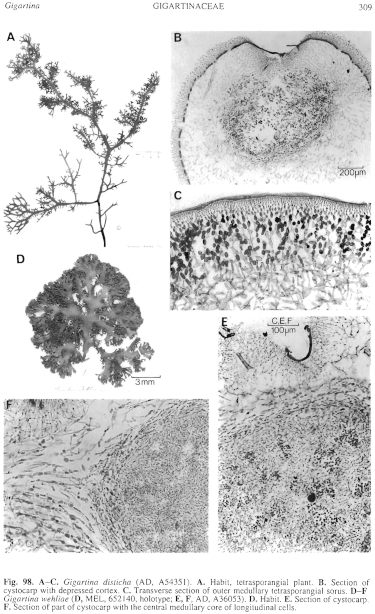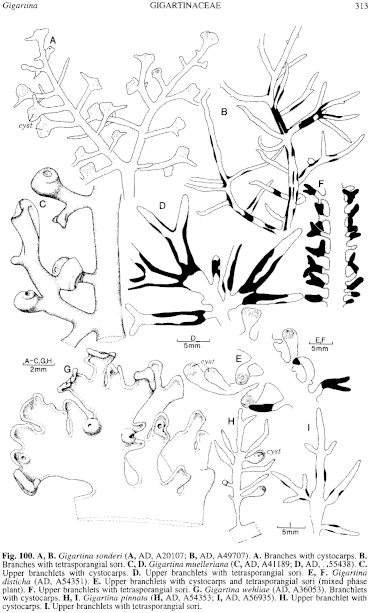|
|
|
|
|
|||||||||||
|
Electronic Flora of South Australia Species Fact Sheet
Phylum Rhodophyta – Class Florideophyceae – Order Gigartinales – Family Gigartinaceae
Selected citations: J. Agardh 1876: 198; 1899: 11. Fuhrer et al. 1981, pls 23,24. Setchell & Gardner 1933: 294.
Thallus (Fig. 98D) dark red to brown-red, erect, 5–15 cm high, drying cartilaginous, complanately branched and more or less ovate in outline, irregularly alternately branched at close intervals, main branches compressed, 5–10 (–15) mm broad, with rounded axils, tapering to 3–5 mm broad, ends more or less digitate with branchlets 1–2 mm broad; main branches with irregularly placed small marginal laterals, mostly 2–5 mm long, simple or 1–3 times furcate, usually with margins slightly thicker, and sometimes with small surface proliferations. Holdfast discoid, 2–3 mm across, with a single frond. Structure of a compact cortex of anticlinal, subdichotomous filaments, outer cells 1–2 µm in diameter and L/D (1–) 2–4, and a medulla of slender anastomosing filaments with a central core of thicker, mainly longitudinal filaments (Fig. 98F).
Reproduction: Sexual thalli monoecious. Carpogonial branches 3-celled, borne on inner cortical (supporting) cells. Cystocarps (Fig. 100G) subterminal in marginal laterals, 0.6–1 mm across, without involucral ramuli, the enveloping tissue slight to moderate, with inner elongate cells (connected with gonimoblast filaments but without transverse filaments) and outer ovoid cells surrounding the carposporophyte (Fig. 98E) with its matrix of areas of massed gonimoblast filaments and large clusters of ovoid carposporangia 5–7 µm in diameter, liberated through a depressed cortical area which disintegrates. Spermatangia in scattered inconspicuous sori, with spermatangia cut off from surface cortical cells and producing ovoid spermatia about 1 µm in diameter.
Tetrasporangial sori not observed.
Type from Port MacDonnell (Wehl)?; holotype in MEL, 652140.
Selected specimens: "Adelaide", S. Aust. (MEL, 652146). Port Elliot, S. Aust. (Hussey, May 1898; AD, A36053). E of Double Corner Beach, Portland Bay, Vic., drift (Beauglehole, 4.vii.1959; MEL, 652142). E of Surry R. mouth, Portland Bay, Vic., drift (Beauglehole, 4.xii.1959; MEL, 652141). Point Roadknight, Vic., drift (Womersley, 6.vi.1953; AD, A18787). Hobart, Tas. (Gunn, MEL, 652145).
Distribution: Port Elliot, S. Aust., to Port Phillip Heads, Vic., and Hobart, Tasmania. Only known from drift specimens.
Taxonomic notes: In his original description, Sonder gave "M'Donnel Bay, Mrs Wehl; Port Phillip Heads, Dr F.v. Willer" as the localities. The plant illustrated by Sonder (MEL, 652140), is without a locality, but the specimen and Sonder's illustration agree particularly well, hence it is regarded as the holotype.
G. wehliae is a rare species, known only from drift specimens on rough-water coasts. It is distinguished by being complanately branched with compressed branches, close, alternate branching, digitate branch ends, and small, marginal, fertile laterals on the lower to mid thallus. Tetrasporangial sori are unknown, and it differs from other southern Australian species of Gigartina in that the carposporangia occur in large clusters separated by masses of sterile filaments. It may prove not to be a species of the Gigartinaceae.
References:
AGARDH, J.G. (1876). Species Genera et Ordines Algarum. Vol. 3, Part 1 - Epicrisis systematis Floridearum, pp. i-vii, 1–724. (Weigel: Leipzig.)
AGARDH, J.G. (1899). Analecta Algologica. Cont. V. Acta Univ. lund. 35, 1–160, Plates 1–3.
FUHRER, B., CHRISTIANSON, I.G., CLAYTON, M.N. & ALLENDER, B.M. (1981). Seaweeds of Australia. (Reed: Sydney.)
SETCHELL, W.A. & GARDNER, N.L. (1933). A preliminary survey of Gigartina, with special reference to its Pacific North American species. Univ. Calif Pubis Bot. 17, 255–340.
SONDER, O.W. (1871). Die Algen des tropischen Australiens. Abh. Nat. Ver. Hamburg 5, 33–74, Plates 1–6.
The Marine Benthic Flora of Southern Australia Part IIIA complete list of references.
Publication:
Womersley, H.B.S. (14 January, 1994)
The Marine Benthic Flora of Southern Australia
Rhodophyta. Part IIIA, Bangiophyceae and Florideophyceae (to Gigartinales)
Reproduced with permission from The Marine Benthic Flora of Southern Australia Part IIIA 1994, by H.B.S. Womersley. Australian Biological Resources Study, Canberra. Copyright Commonwealth of Australia.
Illustrations in Womersley Part IIIA, 1994: FIGS 98 D–F, 100G.

Figure 98 enlarge
Fig. 98. A–C. Gigartina disticha (AD, A54351). A. Habit, tetrasporangial plant. B. Section of cystocarp with depressed cortex. C. Transverse section of outer medullary tetrasporangial sorus. D–F. Gigartina wehliae (D, MEL, 652140, holotype; E, F, AD, A36053). D. Habit. E. Section of cystocarp. F. Section of part of cystocarp with the central medullary core of longitudinal cells.

Figure 100 enlarge
Fig. 100. A, B. Gigartina sonderi (A, AD, A20107; B, AD, A49707). A. Branches with cystocarps. B. Branches with tetrasporangial sori. C, D. Gigartina muelleriana (C, AD, A41189; D, AD, .55438). C. Upper branchlets with cystocarps. D. Upper branchlets with tetrasporangial sori. E, F. Gigartina disticha (AD, A54351). E. Upper branchlets with cystocarps and tetrasporangial sori (mixed phase plant). F. Upper branchlets with tetrasporangial sori. G. Gigartina wehliae (AD, A36053). Branchlets with cystocarps. H, L Gigartina pinnata (H, AD, A54353; I, AD, A56935). H. Upper branchlet with cystocarps. I. Upper branchlets with tetrasporangial sori.

|
Email Contact: State Herbarium of South Australia |

|